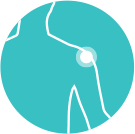Ulnar Nerve Compression
The ulnar nerve is one of the main nerves in your arm which runs from your neck down into your hand. Ulnar nerve compression occurs when the ulnar nerve in the arm becomes compressed or irritated. It can be constricted beneath the collar bone and the wrist, however, it is most commonly constricted inside the elbow.
What is Ulnar Nerve Compression?
The causes of ulnar nerve compression at the elbow may include:
- The build-up of fluid in the elbow, causing swelling and compression of the ulnar nerve
- Bone spurs developing in the elbow pushing against or irritating the nerve
- Injury to the inner anatomy of the elbow
- Arthritis in the elbow
- Everyday activities that include leaning on the elbow for an extended period
- Everyday activity that includes bending and straightening the elbow an excessive amount
- General swelling in the elbow joint
Ulnar Compression Symptoms
The signs and symptoms of ulnar nerve compression may include:
- Elbow joint pain or tenderness, especially on the inside of the arm
- Feeling numbness or ‘pins and needles’ in the ring and pinkie fingers
- Complete loss of sensation in the ring and little fingers
- Weakness in the hand and difficulty maintaining grip strength
- Finding it difficult to control the fingers
- Loss of muscle control in the hand and wrist (in cases that have gone untreated for a long time)
Ulnar Nerve Compression Diagnosis
In order to diagnose your Ulnar nerve compression, Mr Soong Chua will ask some simple questions surrounding the patient’s medical history and general health.
The affected arm will then be examined, observing the range of movement, and identifying which specific movements cause discomfort. This may include testing the grip strength in the hand and fingers, and checking for sensation in the hand.
After this assessment, Mr Soong Chua may suggest further investigations including x-rays, ultrasound and nerve conduction studies to confirm the diagnosis.
Ulnar Nerve Compression Treatment
Depending on the severity of the case and general health of the patient, ulnar nerve compression treatment options will differ.
For less severe cases, a non-surgical option may be optimal. Some cases may be treatable with the aid of a physiotherapist. This may include the use of anti-inflammatory medication, and a brace for the elbow to keep the arm straightened when needed.
Surgery
In some cases, ulnar nerve de-compression surgery will be needed. The severity of the case, will impact the type of ulnar nerve compression surgery that is performed. Mr Soong Chua will determine whether the compressed ulnar nerve requires a cubital tunnel release, an ulnar nerve anterior transposition or a combination of these. Each surgery requires a small incision, and can be performed under general or regional anaesthesia depending on the individual patient.
The ulnar nerve sits within the cubital tunnel. In order to relieve the compression on the ulnar nerve, Mr Soong Chua may perform a surgery that releases or opens up the cubital tunnel.
To reduce the risk of recurrent compression, Mr Soong Chua may choose to perform an ulnar nerve transposition at the same time. The ulnar nerve is repositioned from behind the elbow joint to in front of the joint and muscles. This frees the ulnar nerve from compression by the muscle, when the elbow is bent.
Mr Soong Chua will determine which surgery is most suitable for the individual patient’s case.





